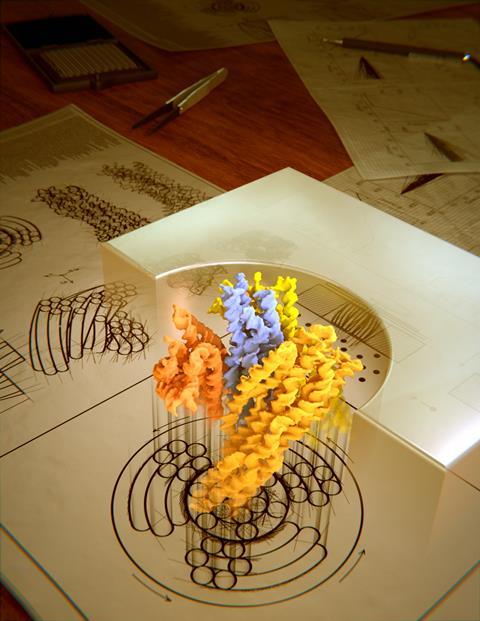An international team has created a turbine based on DNA origami in a nanopore that converts electrical energy into mechanical work, Nature Nanotechnology reports.
Turbines can be found at the macroscale – windmills – and the nanoscale – ATP synthase – but assembling a turbine at the nanoscale has been a difficult task until now. An international team, including Cees Dekker’s group at TU Delft, has now succeeded in making a turbine out of DNA origami that you can actually power with electrical energy.
We have previously written about DNA origami, in which you take a large piece of circular DNA and fold it with hundreds of tiny DNA staples. Because DNA is complementary, you can code the staple strands in such a way that you get very precise two- and three-dimensional structures. In this way, the researchers built a central axis, which they fitted with three chiral rotor blades.
An axis with rotors is great, but when it’s floating in solution it can’t convert energy into work, so they placed their DNA structure in a nanopore in a silicon nitride (SiNx) membrane via diffusiophoresis. With an electric direct current or a difference in ion concentration, the turbine can reach a speed of 10 revolutions per second. This makes the origami turbine very similar in size (±25 nm), speed and torque to the rotor of ATP synthase.
For both the electrical stimulation and the difference in ion concentration, the turbine rotated as would be expected depending on the chirality. However, when the concentration of Na+ ions was significantly increased to 3 M (instead of 50 mM as in their earlier experiments), the direction of rotation of the turbine in the electrical experiments changed. So if the turbine was spinning anti-clockwise at a given chirality, at a higher concentration it spins the other way when you apply a current to it. This reversal was found to occur between 0.5 and 1 M NaCl. They confirmed these observations with molecular dynamics simulations.
The researchers expect this to be a big boost for nanomachines that can also function under physiological conditions and in a biocompatible way. Who knows, Ben Feringa’s molecular cars could soon be turned into turbine-powered nanoboats or nanoplanes.

Shi, X. et al. (2023) Nat. Nanotechnol., DOI: 10.1038/s41565-023-01527-8













Nog geen opmerkingen